Recent Writings About Australian Comics (2017-2021)
One of the reasons why I have only made infrequent blog posts during the last 12-18 months is that I have been preoccupied with various academic/scholarly writing projects. "Publish or perish" is the commonly heard mantra repeated to "early career researchers" like myself, as your chances of securing postdoctoral research grants and/or semi-secure full-time employment is based in part on your academic writing output. Well, that's the theory, anyway - the reality, for me at least, has been far from encouraging. Despite being told on numerous occasions that I have produced an impressive body of work (relative to opportunity) - spanning academic monographs, scholarly book chapters and peer-reviewed journal articles - I am no closer to achieving these career goals since I completed my doctoral thesis at Monash University nearly seven years ago. But this is the professional reality confronting even the best and brightest scholars in the arts & humanities disciplines, both here in the United States (where I currently live and presently teach at Fordham University), and in Australia, where I worked as a sessional university tutor for several years before moving abroad.
Nevertheless, I am proud of the work I've done in the emerging field of "comics studies" in the last five years, so I'd like to take this opportunity to share news and information about my recent writings on Australian comics, which I will hope interest readers of this blog.
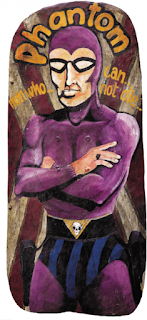
Man Who Cannot Die: Phantom Shields of the New Guinea Highlands (Jonathan Fogel, Ed., Boylan & Philips, 2021) is a beautifully presented art book, which documents the representation of the Phantom on ceremonial and tribal war shields in the Western Highlands of Papua New Guinea. This American comic strip character, created by author Lee Falk and illustrator Ray Moore in 1936, has always had a devoted following throughout Australia and the Oceanic region, but this remarkable phenomenon of Phantom as a tribal art icon may come as a surprise to even the most ardent Phantom "phan". I contributed a chapter to this book, titled "The Phantom's Oceanic Odyssey", which explains how Papuan audiences were first exposed to The Phantom comic strip in the 1970s through the pages of Wantok, a fortnightly Catholic newspaper printed in Tok Pisin, a widely-spoken dialect that is one of Papua New Guinea's three official languages, alongside English and Hiri Motu. Copies can be ordered directly from the publisher via the website link listed above, but Australian readers can also order copies via Frew Publications, which publishes the Australian edition of The Phantom comic book.
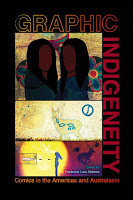 Graphic Indigeneity: Comics in the Americas and Australasia
(Frederick Luis
Graphic Indigeneity: Comics in the Americas and Australasia
(Frederick LuisAldama, Ed., University Press of Mississippi, 2020) is a collection of scholarly essays which examines how mainstream (American) comics have portrayed indigenous peoples in the Americas, and how present-day indigenous storytellers are using comics to reclaim their narrative, through documenting the complexities of their shared histories, and conveying the realities of their present-day existence. My contribution to this collection, titled "The Wisdom of the Phantom: The Secret Life of Australia's Indigenous Superhero", looks at how Australian government agencies (such as the Australian Electoral Commission and Family Court of Australia) have capitalised on the Phantom's popularity among indigenous Australian audiences by using the character in a range of educational comics and other materials devoted to such topics as voting registration, divorce and family custody disputes, and sexually transmitted diseases.
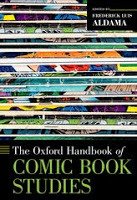 The Oxford Handbook of Comic Book Studies
(Frederick Luis Aldama, Ed., Oxford University Press, 2020) is surely proof positive that comic books have now acquired academic legitimacy, even if there is residual & institutional uncertainty about whether comics should be studied as either a form of literature, or as a visual artform - or both, for that matter. This wide-ranging collection of essays considers the formal/aesthetic parameters of the comic book medium, the formation and evolution of the comics studies discipline, media and merchandise adaptations of comic book characters, and broader political/social issues addressed in comic books and graphic novels, past and present. My contribution to this volume, titled "Radical Graphics: Australia's Second-Phase Comics", briefly recounts the history of academic studies of comic books in Australia (beginning at the height of the "anti-comic book" outcry of the late 1940s/early 1950s), before charting the evolution of the so-called "underground comix" and "small press/alternative comics" movements of the 1970s and 1980s. It also discusses the formation of organised Australian comics fandom throughout this period, and how the emerging network of comic fanzines, specialty comics retailers and comic-book conventions facilitated the growth of "New Wave" Australian comics.
The Oxford Handbook of Comic Book Studies
(Frederick Luis Aldama, Ed., Oxford University Press, 2020) is surely proof positive that comic books have now acquired academic legitimacy, even if there is residual & institutional uncertainty about whether comics should be studied as either a form of literature, or as a visual artform - or both, for that matter. This wide-ranging collection of essays considers the formal/aesthetic parameters of the comic book medium, the formation and evolution of the comics studies discipline, media and merchandise adaptations of comic book characters, and broader political/social issues addressed in comic books and graphic novels, past and present. My contribution to this volume, titled "Radical Graphics: Australia's Second-Phase Comics", briefly recounts the history of academic studies of comic books in Australia (beginning at the height of the "anti-comic book" outcry of the late 1940s/early 1950s), before charting the evolution of the so-called "underground comix" and "small press/alternative comics" movements of the 1970s and 1980s. It also discusses the formation of organised Australian comics fandom throughout this period, and how the emerging network of comic fanzines, specialty comics retailers and comic-book conventions facilitated the growth of "New Wave" Australian comics.
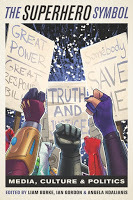 The Superhero Symbol: Media, Culture & Politics
(Liam Burke, Ian Gordon & Angela Ndalianis, Eds., Rutgers University Press, 2019) is a multidisciplinary collection of essays which examines different facets of the superhero genre that has come to dominate both the American comics industry and television/film sectors in recent decades. The comic book medium, at least within the Anglo-American, English-speaking world, is inextricably linked to the superhero genre. This volume features scholarly essays, as well as interviews with leading comics practitioners, that examine the commercial exploitation of superheroes in other media, the symbolic and ideological dimensions of the superhero genre, and how superheroes have articulated aspects of national identity throughout the world. My essay, titled "Age of the Atoman: Australian Superhero Comics and Cold War Modernity", looks at how Australian cartoonists promoted their superheroes as American, rather than Australian characters. This tactic that acknowledged the commercial realities of Australia's post-war comics industry, and reflected the enduring legacy of Australia's "cultural cringe" - the ingrained belief that Australia's cultural achievements were inherently inferior to their British or American equivalents.
The Superhero Symbol: Media, Culture & Politics
(Liam Burke, Ian Gordon & Angela Ndalianis, Eds., Rutgers University Press, 2019) is a multidisciplinary collection of essays which examines different facets of the superhero genre that has come to dominate both the American comics industry and television/film sectors in recent decades. The comic book medium, at least within the Anglo-American, English-speaking world, is inextricably linked to the superhero genre. This volume features scholarly essays, as well as interviews with leading comics practitioners, that examine the commercial exploitation of superheroes in other media, the symbolic and ideological dimensions of the superhero genre, and how superheroes have articulated aspects of national identity throughout the world. My essay, titled "Age of the Atoman: Australian Superhero Comics and Cold War Modernity", looks at how Australian cartoonists promoted their superheroes as American, rather than Australian characters. This tactic that acknowledged the commercial realities of Australia's post-war comics industry, and reflected the enduring legacy of Australia's "cultural cringe" - the ingrained belief that Australia's cultural achievements were inherently inferior to their British or American equivalents.
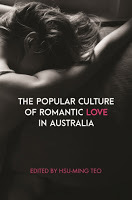 The Popular Culture of Romantic Love in Australia (Hsu-Ming Teo, Ed., Australian Scholarly Publishing, 2017). This volume examines the rituals and representations of romantic love in Australian society, from the mid-19th century to the present day. There is extensive discussion about the portrayal of romantic love in Australian cinema, television, paperback novels, and popular music. My essay, titled "Intimate Confessions: The Rise and Fall of Romance Comic Books in Australia", charts the controversial history of romance comic books in Australia, a field dominated by licensed reprints of American titles, but which also provided openings for local creators, including Moira Bertram, one of the few women to enjoy a lengthy and successful career in Australian comics. I am especially proud of this chapter, because it really does break new ground in documenting the history of Australian comics, by focusing on the neglected romance comics genre, which was responsible for broadening the historically juvenile audience for comics, by addressing such topics as romantic love, courtship, sexual intimacy and marriage that appealed to teenage girls and young women alike, who made these comics bestsellers.
The Popular Culture of Romantic Love in Australia (Hsu-Ming Teo, Ed., Australian Scholarly Publishing, 2017). This volume examines the rituals and representations of romantic love in Australian society, from the mid-19th century to the present day. There is extensive discussion about the portrayal of romantic love in Australian cinema, television, paperback novels, and popular music. My essay, titled "Intimate Confessions: The Rise and Fall of Romance Comic Books in Australia", charts the controversial history of romance comic books in Australia, a field dominated by licensed reprints of American titles, but which also provided openings for local creators, including Moira Bertram, one of the few women to enjoy a lengthy and successful career in Australian comics. I am especially proud of this chapter, because it really does break new ground in documenting the history of Australian comics, by focusing on the neglected romance comics genre, which was responsible for broadening the historically juvenile audience for comics, by addressing such topics as romantic love, courtship, sexual intimacy and marriage that appealed to teenage girls and young women alike, who made these comics bestsellers.
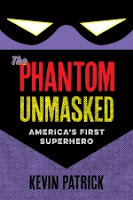 The Phantom Unmasked: America's First Superhero
(University of Iowa Press, 2017) was my first academic monograph, and the first book-length academic study of the Phantom, the American comic-strip character which provided the visual template for comic-book superheroes, and who predates the 1938 debut of Superman by two years. The Phantom Unmasked is based on my doctoral thesis (Monash University, 2014), which charted the production and dissemination of The Phantom comic strip (and subsequent comic magazines) in three international markets - Australia, Sweden and India - where the character has remained incredibly popular with generations of readers in each of these countries since the 1930s. This book features insights from key creative personnel associated with The Phantom comics franchise, and uses findings from an international survey of nearly 600 Phantom "phans" to explain why America's first superhero, largely forgotten or ignored by American audiences, has enjoyed unrivalled levels of international popularity. Don't believe me? Then check out the video interview I recorded for Fordham News back in 2018, and I'll 'give you the drum' about The Ghost Who Walks myself!
The Phantom Unmasked: America's First Superhero
(University of Iowa Press, 2017) was my first academic monograph, and the first book-length academic study of the Phantom, the American comic-strip character which provided the visual template for comic-book superheroes, and who predates the 1938 debut of Superman by two years. The Phantom Unmasked is based on my doctoral thesis (Monash University, 2014), which charted the production and dissemination of The Phantom comic strip (and subsequent comic magazines) in three international markets - Australia, Sweden and India - where the character has remained incredibly popular with generations of readers in each of these countries since the 1930s. This book features insights from key creative personnel associated with The Phantom comics franchise, and uses findings from an international survey of nearly 600 Phantom "phans" to explain why America's first superhero, largely forgotten or ignored by American audiences, has enjoyed unrivalled levels of international popularity. Don't believe me? Then check out the video interview I recorded for Fordham News back in 2018, and I'll 'give you the drum' about The Ghost Who Walks myself!Even though I remain (justifiably) pessimistic about my long-term academic employment prospects, I still enjoy teaching, especially now that I've had the chance to design and deliver my own course, Comic Books and American Culture, at Fordham University for the last two years. And there are still other topics about Australian comics history that I hope to explore in different academia outlets in years to come, which I will share here as well.



